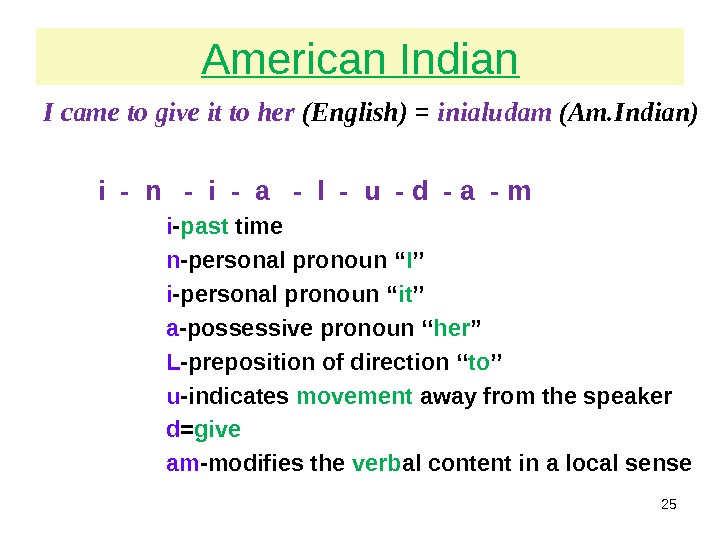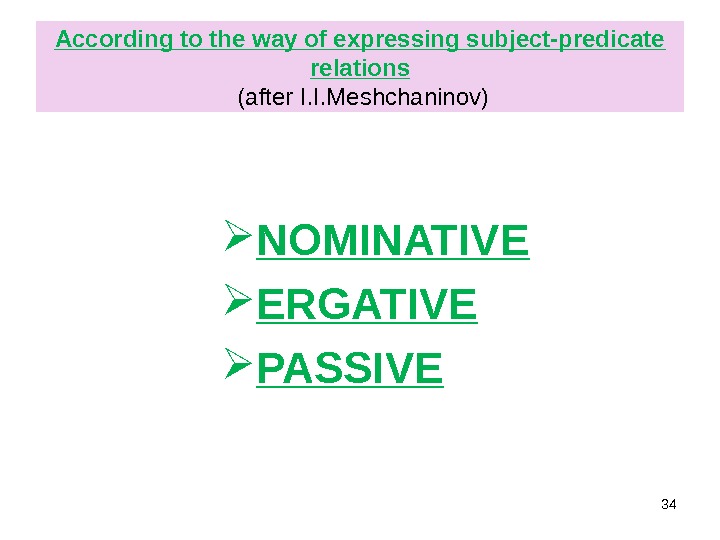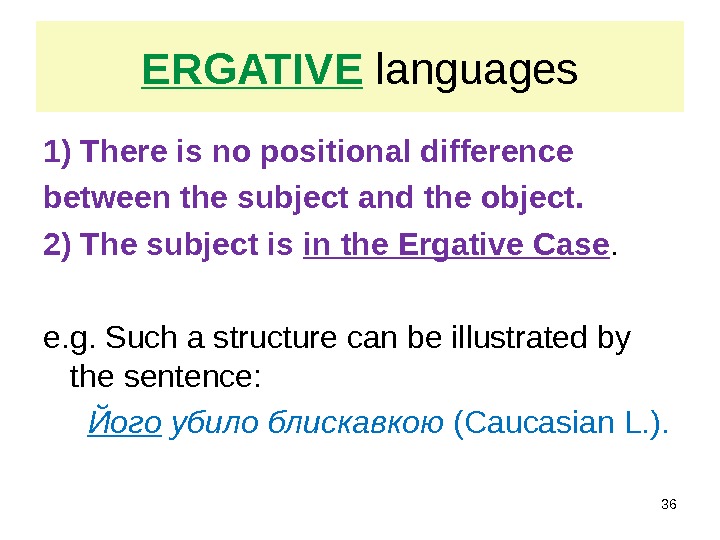History of Comparative Linguistics •










































- Размер: 1.3 Mегабайта
- Количество слайдов: 41
Описание презентации History of Comparative Linguistics • по слайдам

 History of Comparative Linguistics • the end of the 18 thth century up to the middle of the 19 thth century, which is called the beginning of comparative research; • the end of the 19 thth century – the period of neogrammarian studies, when linguists started comparing living languages; • the beginning of the 20 thth century up to the present – the period of structural and functional approaches to language.
History of Comparative Linguistics • the end of the 18 thth century up to the middle of the 19 thth century, which is called the beginning of comparative research; • the end of the 19 thth century – the period of neogrammarian studies, when linguists started comparing living languages; • the beginning of the 20 thth century up to the present – the period of structural and functional approaches to language.
 CLAUDE LANCELOT, ANTOINE ARNAUD ‘‘ Universal or Rational Grammar ’’ (Pour Royal Monastery 1660), was an attempt to create grammar on ‘‘ common in all languages principles ’’.
CLAUDE LANCELOT, ANTOINE ARNAUD ‘‘ Universal or Rational Grammar ’’ (Pour Royal Monastery 1660), was an attempt to create grammar on ‘‘ common in all languages principles ’’.
 Summary 1) The historical and comparative method was originally employed to diachronically investigate genealogically related languages , principally Indian, Germanic and Romanic. 2) At the same time general observations in non-related languages were being carried out. These observations helped to establish the languages ’ isomorphic and allomorphic features. Thus, together with the historical and comparative study, typological investigations were born.
Summary 1) The historical and comparative method was originally employed to diachronically investigate genealogically related languages , principally Indian, Germanic and Romanic. 2) At the same time general observations in non-related languages were being carried out. These observations helped to establish the languages ’ isomorphic and allomorphic features. Thus, together with the historical and comparative study, typological investigations were born.
 Wilhelm von Humboldt (1767 -1835) The father of typology
Wilhelm von Humboldt (1767 -1835) The father of typology
 WILHELM VON HUMBOLDT is considered to be the father of typology. grouped all known to him languages into the four classes. suggested evolutionary theory. explained the divergences found in languages with the help of existence of ethnic psychology. used the notion of folk ’ s spirit represented in national language.
WILHELM VON HUMBOLDT is considered to be the father of typology. grouped all known to him languages into the four classes. suggested evolutionary theory. explained the divergences found in languages with the help of existence of ethnic psychology. used the notion of folk ’ s spirit represented in national language.
 WILHELM VON HUMBOLDT`S classification 1) isolating languages, which are devoid of the form-building morphemes (like Chinese ); 2) agglutinative languages ( like those of the Turkic group ); 3) flexional languages (like the Indo-European and Semitic languages ); 4) incorporating languages of American Indians , which are characterized by the possibility of words to combine and form specific word-sentences.
WILHELM VON HUMBOLDT`S classification 1) isolating languages, which are devoid of the form-building morphemes (like Chinese ); 2) agglutinative languages ( like those of the Turkic group ); 3) flexional languages (like the Indo-European and Semitic languages ); 4) incorporating languages of American Indians , which are characterized by the possibility of words to combine and form specific word-sentences.
 WILHELM VON HUMBOLDT`S evolutionary theory The isolating languages the agglutinative languages the inflexional languages
WILHELM VON HUMBOLDT`S evolutionary theory The isolating languages the agglutinative languages the inflexional languages
 WILHELM VON HUMBOLDT`S evolutionary theory The isolating languages were considered by him to be archaic , the agglutinative – to be at the intermediary stage of development and the inflexional ones as those representing the highest degree in language evolution.
WILHELM VON HUMBOLDT`S evolutionary theory The isolating languages were considered by him to be archaic , the agglutinative – to be at the intermediary stage of development and the inflexional ones as those representing the highest degree in language evolution.
 SUMMARY: • IN THE FIRST HALF OF THE 19 TH CENTURY TYPOLOGICAL INVESTIGATIONS WERE BASED ON THE MORPHOLOGICAL PRINCIPLE. • different structural types of languages were shown as the stages of one process of the development of languages in general as the movement from less perfect to more perfect.
SUMMARY: • IN THE FIRST HALF OF THE 19 TH CENTURY TYPOLOGICAL INVESTIGATIONS WERE BASED ON THE MORPHOLOGICAL PRINCIPLE. • different structural types of languages were shown as the stages of one process of the development of languages in general as the movement from less perfect to more perfect.
 19 th century 1. All through the second half of the 19 th century the only object of typological investigation was a word / word-form. 2. It was investigated with an accent on its common and divergent features with the aim to establish a universal morphological classification. 3. Nevertheless, in some researches the object of investigation has moved from morphology to syntax.
19 th century 1. All through the second half of the 19 th century the only object of typological investigation was a word / word-form. 2. It was investigated with an accent on its common and divergent features with the aim to establish a universal morphological classification. 3. Nevertheless, in some researches the object of investigation has moved from morphology to syntax.
 20 th C. TYPOLOGICAL INVESTIGATIONS: • MULTILATERAL OR GRADED TYPOLOGY • CHARACTEREOLOGICAL TYPOLOGY • QUANTITATIVE TYPOLOGY
20 th C. TYPOLOGICAL INVESTIGATIONS: • MULTILATERAL OR GRADED TYPOLOGY • CHARACTEREOLOGICAL TYPOLOGY • QUANTITATIVE TYPOLOGY
 Edward Sapir 13 MULTILATERAL OR GRADED TYPOLOGY
Edward Sapir 13 MULTILATERAL OR GRADED TYPOLOGY
 MULTILATERAL OR GRADED TYPOLOGY the American linguist Edward Sapir. suggested TWO PARAMETERS: a) the degree of cohesion between the root and the affixal morphemes in a word : 1) isolating (no formal elements), 2) agglutinative (affixal morphemes don ’ t cause the changes in root morpheme), 3) fusional (when it is difficult to find the boundary between the root and the affixal morphemes), 4) symbolic (root morphemes change because of the shift of the stress , the change of intonation etc); b) the degree of synthesis: 1) analytical, 2) synthetic 3) polysynthetic languages.
MULTILATERAL OR GRADED TYPOLOGY the American linguist Edward Sapir. suggested TWO PARAMETERS: a) the degree of cohesion between the root and the affixal morphemes in a word : 1) isolating (no formal elements), 2) agglutinative (affixal morphemes don ’ t cause the changes in root morpheme), 3) fusional (when it is difficult to find the boundary between the root and the affixal morphemes), 4) symbolic (root morphemes change because of the shift of the stress , the change of intonation etc); b) the degree of synthesis: 1) analytical, 2) synthetic 3) polysynthetic languages.
 Summary 1. Of special attention in the 20 th century were questions concerning the ways of contrasting the microsystems of related and non-related languages with the aim of investigating morphological and functional features. 2. At the same time syntactic relations ( C. Bazell, I. I. Meshchaninov ) and phonological features ( N. Trubetskoy, Ch. Hockett, O. Isachenko ) were taken into account.
Summary 1. Of special attention in the 20 th century were questions concerning the ways of contrasting the microsystems of related and non-related languages with the aim of investigating morphological and functional features. 2. At the same time syntactic relations ( C. Bazell, I. I. Meshchaninov ) and phonological features ( N. Trubetskoy, Ch. Hockett, O. Isachenko ) were taken into account.
 TYPOLOGICAL CLASSIFICATIONS 1. Morphological 2. Phonological 3. Syntactic
TYPOLOGICAL CLASSIFICATIONS 1. Morphological 2. Phonological 3. Syntactic
 MORPHOLOGICAL CLASSIFICATION (after W. Humboldt)
MORPHOLOGICAL CLASSIFICATION (after W. Humboldt)
 MORPHOLOGICAL CLASSIFICATION 1. THE ISOLATING l anguages 2. THE AGGLUTINATIVE languages 3. THE FLEXIONAL languages 4. THE INCORPORATING / POLYSYNTHETIC languages
MORPHOLOGICAL CLASSIFICATION 1. THE ISOLATING l anguages 2. THE AGGLUTINATIVE languages 3. THE FLEXIONAL languages 4. THE INCORPORATING / POLYSYNTHETIC languages
 the isolating l anguages are devoid of the form-building morphemes, they are also called amorphous or formless. Grammatical relations in these L. are expressed by word order. The best specimen of an I. L. is Chinese , which is monosyllabic and invariable.
the isolating l anguages are devoid of the form-building morphemes, they are also called amorphous or formless. Grammatical relations in these L. are expressed by word order. The best specimen of an I. L. is Chinese , which is monosyllabic and invariable.
 Chinese A TONAL L. and the meanings of words of the same structure are distinguished by 1. tones and 2. position of the word in the sentence.
Chinese A TONAL L. and the meanings of words of the same structure are distinguished by 1. tones and 2. position of the word in the sentence.
 The exact meaning is made clear by tones and positions in the sentence.
The exact meaning is made clear by tones and positions in the sentence.
 the agglutinative languages 1) monosemantic and standard suffixes , so called ‘‘ stickers ’’ , 2) a strictly prescribed order of suffixes etc. ( okul ‘‘ школа ’’ , okul lar ‘‘ школ и ’’ , okullar imiz ‘‘ наші школи ’’ , okullarimiz da ‘‘ в наших школах ” ) These features are permanent for Turkic languages , so it is possible to contrast them to another group of languages.
the agglutinative languages 1) monosemantic and standard suffixes , so called ‘‘ stickers ’’ , 2) a strictly prescribed order of suffixes etc. ( okul ‘‘ школа ’’ , okul lar ‘‘ школ и ’’ , okullar imiz ‘‘ наші школи ’’ , okullarimiz da ‘‘ в наших школах ” ) These features are permanent for Turkic languages , so it is possible to contrast them to another group of languages.
 the flexional languages The form of a word changes to show a change in meaning or grammatical function. Often there is no clear boundary between the root and the part which shows the grammatical meaning: mice (mouse + plural ) Indo-European as Greek, Latin, English, Russian, Ukrainian etc. and Semitic languages
the flexional languages The form of a word changes to show a change in meaning or grammatical function. Often there is no clear boundary between the root and the part which shows the grammatical meaning: mice (mouse + plural ) Indo-European as Greek, Latin, English, Russian, Ukrainian etc. and Semitic languages
 the incorporating / polysynthetic languages of American Indians with no word / sentence distinction which are characterized by the possibility of words to combine and form specific sentence structures.
the incorporating / polysynthetic languages of American Indians with no word / sentence distinction which are characterized by the possibility of words to combine and form specific sentence structures.
 American Indian I came to give it to her (English) = inialudam (Am. Indian) i — n — i — a — l — u — d — a — m i — past time n -personal pronoun ‘‘ I ’’ i -personal pronoun ‘‘ it ’’ a -possessive pronoun ‘‘ her ’’ L -preposition of direction ‘‘ to ’’ u -indicates movement away from the speaker d = give am -modifies the verb al content in a local sense
American Indian I came to give it to her (English) = inialudam (Am. Indian) i — n — i — a — l — u — d — a — m i — past time n -personal pronoun ‘‘ I ’’ i -personal pronoun ‘‘ it ’’ a -possessive pronoun ‘‘ her ’’ L -preposition of direction ‘‘ to ’’ u -indicates movement away from the speaker d = give am -modifies the verb al content in a local sense
 PHONOLOGICAL CLASSIFICATION
PHONOLOGICAL CLASSIFICATION
 PHONOLOGICAL CLASSIFICATION (after O. Isachenko) • CONSONENTAL • VOCALI
PHONOLOGICAL CLASSIFICATION (after O. Isachenko) • CONSONENTAL • VOCALI
 CONSONENTAL l anguages dominates the system of consonants which is characterized by the variety of consonantal phonemes and the small number of vocalic phonemes – Ukrainian, Russian, Polish
CONSONENTAL l anguages dominates the system of consonants which is characterized by the variety of consonantal phonemes and the small number of vocalic phonemes – Ukrainian, Russian, Polish
 VOCALIC languages dominates the system of vocalic phonemes with the limited number of consonants, and the number of vowels exceeds the average number of vocalic phonemes – English, German, Slovenian, Serbian-Croat
VOCALIC languages dominates the system of vocalic phonemes with the limited number of consonants, and the number of vowels exceeds the average number of vocalic phonemes – English, German, Slovenian, Serbian-Croat
 syntactic classifications
syntactic classifications
 according to the type OF gramma. TICAL word-formation : SYNTHETIC languages, in which the grammatical relations between words are expressed by forms of the words themselves. ANALYTICAL languages, in which the grammatical relations are expressed by means of prepositions. They are also characterized by the use of auxiliary words and a fixed word order ( S-V-O ).
according to the type OF gramma. TICAL word-formation : SYNTHETIC languages, in which the grammatical relations between words are expressed by forms of the words themselves. ANALYTICAL languages, in which the grammatical relations are expressed by means of prepositions. They are also characterized by the use of auxiliary words and a fixed word order ( S-V-O ).
 The change of placement of the elements is possible in synthetic L. only. Compare: e. g. The hunter killed the bear & The bear killed the hunter , e. g. Мисливець убив ведмедя = Ведмедя убив мисливець.
The change of placement of the elements is possible in synthetic L. only. Compare: e. g. The hunter killed the bear & The bear killed the hunter , e. g. Мисливець убив ведмедя = Ведмедя убив мисливець.
 Ivan I. Meshchaninov (1883 Ufa — 1967 Leningrad)
Ivan I. Meshchaninov (1883 Ufa — 1967 Leningrad)
 According to the way of expressing subject-predicate relations (after I. I. Meshchaninov) NOMINATIVE ERGATIVE PASSIV
According to the way of expressing subject-predicate relations (after I. I. Meshchaninov) NOMINATIVE ERGATIVE PASSIV
 NOMINATIVE languages the subject stands for the doer of the action and is expressed in the Nominative Case (Indo-European and Semitic L. ). subject in the Nom. Case=doer of the action
NOMINATIVE languages the subject stands for the doer of the action and is expressed in the Nominative Case (Indo-European and Semitic L. ). subject in the Nom. Case=doer of the action
 ERGATIVE languages 1) There is no positional difference between the subject and the object. 2) The subject is in the Ergative Case. e. g. Such a structure can be illustrated by the sentence: Його убило блискавкою (Caucasian L. ).
ERGATIVE languages 1) There is no positional difference between the subject and the object. 2) The subject is in the Ergative Case. e. g. Such a structure can be illustrated by the sentence: Його убило блискавкою (Caucasian L. ).
 PASSIVE languages Neither the subject nor the object have special grammatical forming up within the syntactic unit. They merge with the verb-predicate into a single unit , in which the predicate is a leading component (incorporative L. ).
PASSIVE languages Neither the subject nor the object have special grammatical forming up within the syntactic unit. They merge with the verb-predicate into a single unit , in which the predicate is a leading component (incorporative L. ).
 N. S. Trubetskoy 38 studied phonological systems of many languages ( ‘‘ The grounds of Phonology ’’ ).
N. S. Trubetskoy 38 studied phonological systems of many languages ( ‘‘ The grounds of Phonology ’’ ).
 F. F. Fortunatov 39 added to Humboldt ’ s classification flexional-agglutinative type of language.
F. F. Fortunatov 39 added to Humboldt ’ s classification flexional-agglutinative type of language.
 I. I. Meshchaninov classified languages according to the positions of the subject and the predicate in the sentence. G. P. Melnikov proposed theory of determinants (on the basis of the dominant features). R. Yakobson studied language universals.
I. I. Meshchaninov classified languages according to the positions of the subject and the predicate in the sentence. G. P. Melnikov proposed theory of determinants (on the basis of the dominant features). R. Yakobson studied language universals.
 Yu. O. Zhluktenko – studied English and Ukrainian languages and their interrelations in the North-American countries. O. Isachenko – investigated Slavonic languages. He divided languages into vocalic and consonantal on the principle of their quantitative representation. M. A. Kalinovich – morphological divergencies in European and South-Asian languages. R. P. Zorivchak – studied English and Ukrainian correspondencies in nominating different things and objects of the surrounding world with an accent on their national peculiarities.
Yu. O. Zhluktenko – studied English and Ukrainian languages and their interrelations in the North-American countries. O. Isachenko – investigated Slavonic languages. He divided languages into vocalic and consonantal on the principle of their quantitative representation. M. A. Kalinovich – morphological divergencies in European and South-Asian languages. R. P. Zorivchak – studied English and Ukrainian correspondencies in nominating different things and objects of the surrounding world with an accent on their national peculiarities.

